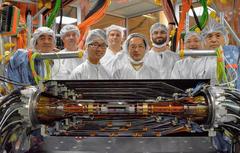First collisions in the Belle II detector. Image: Belle II / KEK
Let the search begin: for the first time after the completion of the massive reconstruction of the accelerator and detector, collisions occurred today in the upgraded Belle II particle detector at the Japanese KEK research centre. This is the official start of Belle II's research programme. Belle II is an international research cooperation with key participation by DESY and eleven other institutes in Germany. A total of 900 scientists from 26 countries are involved.
Over the next years, Belle II is set to deliver 50 times more than its predecessor (Belle), thus hopefully getting to the bottom of some of the still unresolved big questions in particle physics. These include questions such as why we only see matter in the universe, although the Big Bang must have produced matter and antimatter in equal amounts, or what the mysterious so-called dark matter consists of that makes up a large part of the universe. The large amounts of data will make it possible to measure physical phenomena so accurately that even tiny deviations from the theoretical foundation, the so-called standard model of particle physics, become visible. Everything revolves around so-called B mesons, which the Belle II team will use to see if they can detect deviations from the theoretically predicted behaviour of these particles that consist of a bottom quark or a bottom antiquark.
"This is the beginning of an exciting physics adventure, and we are extremely excited about the data that the detector will provide us with," says Carsten Niebuhr, Belle II researcher at DESY. "The vertex detector, which was developed and built in Germany, will play a decisive role in this adventure.”
Over the last nine years, the research facility has been completely rebuilt. Thanks to novel magnets and many technological improvements, the accelerator KEKB, which collides electrons with their antiparticles, positrons, became SuperKEKB. SuperKEKB is now able to generate a much smaller beam spot and at the same time increase beam intensity. This leads to a much higher data rate, which in turn makes physics analyses of very rare phenomena possible. However, it also leads to much more unwanted data, the so-called background, which provides a challenge for the sensitive detector components and for data analysis because the relevant events have to be filtered out.
Which in turn meant that the Belle detector also had to be upgraded, evolving into Belle II. Right in the centre of the new particle camera, which measures about eight meters in diameter and weighs 1400 tons, the so-called vertex detector measures the production point og the newly generated particles in the collisions with highest precision. It consists of two independent components and was the very last one to be inserted into Belle II in November due to its sensitivity. The inner part of the vertex detector is a new pixel detector developed in Germany. This highly sensitive detector consists of two half-shells, is only about the size of a soda can and was extensively tested at DESY last year before being transported to Japan.
Initially, the particles at SuperKEKB collide with a low beam intensity. Gradually, the accelerator physicists will increase the beam power until full power is reached and new phenomena come within reach. An excellent understanding of the detectors is a prerequisite for the desired precision measurements. With the data recorded over the next few months, all subdetectors will therefore first be carefully calibrated and the functionality of Belle II tested and optimised by measuring very well known physical quantities. The physics programme of Belle II is designed for about 10 years.
The Belle II collaborative research funding funded by the BMBF is embedded in the framework programme "Research into Universe and Matter (ErUM)".








